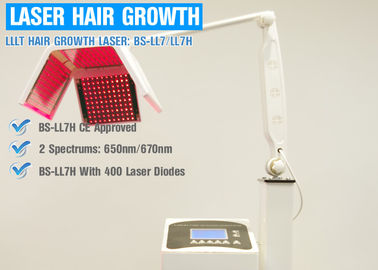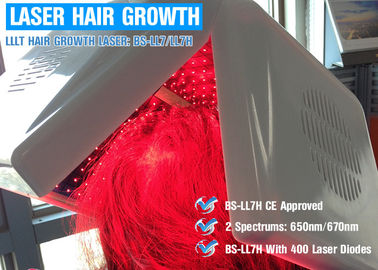650nm / 670nm Diode Laser Hair Regrowth Device For Hair Loss Treatment
Product Details:
| Place of Origin: | Shanghai |
| Brand Name: | Sincery |
| Certification: | CE,ISO13485,FDA |
| Model Number: | H |
Payment & Shipping Terms:
| Minimum Order Quantity: | 1 unit |
|---|---|
| Price: | Negotiated |
| Packaging Details: | Standard export packing |
| Delivery Time: | 2-3 days after payment |
| Payment Terms: | L/C, T/T, Western Union, MoneyGram |
| Supply Ability: | 500 unit per month |
|
Detail Information |
|||
| Laser Source: | Diode Laser | Wavelength: | 650nm / 670nm |
|---|---|---|---|
| Laser Energy: | Max. 20 Mw Per Diode | Total Laser Amount: | 400 |
| Laser Feature: | Energy Adjustable, Panel Can Be Controlled Separately | Timer: | Support (1 – 60 Min) |
| Microcurrent Therapy: | Handheld Probe + Comb | Radiation Dimension: | 550 X 350 Mm |
| Highlight: | low light laser therapy for hair loss,laser hair growth equipment |
||
Product Description
Totally 400 high quality laser diodes hair loss treatment equipment
Laser hair rejuvenation may help prevent hair loss. Laser brushes use laser therapy to revitalize and nourish hair follicles. If the laser brush is used properly, patients may see results of thicker and fuller hair. I highly recommend talking with a board certified dermatologist with experience in hair loss and restoration to discuss all your hair loss prevention options to determine the best treatment for you. It is hard for most patients to apply a laser brush for 15 minutes on all areas of baldness three times per week with consistency. A new option is the laser cap which has LED lights using the 633 wavelength which is easy for anyone to use but the cost will be prohibitive for most. The red laser light is used after hair transplant surgery to speed the recovery and improve the swelling and the redness. Most experts feel it is helpful used in this way.
Laser Hair Therapy is a non-chemical, non-invasive treatment that is being used around the U.S. for the treatment of hair loss. Like other treatments (such as Propecia and Minoxidil), some patients tend to respond better than others. In general, it seems that patients who ‘have more hair’ (perhaps in early stages of hair loss) tend to have better results. Large-scale clinical trials have yet to be performed. However, many men and women are seeing positive changes in their hair in response to these types of treatments.
![]()
![]()
![]()
![]()
This type of therapy isn't suitable for everyone with hair loss.
In fact, at this point it's important to note that you MUST initially speak to your doctor, rather than spend money on an expensive treatment or device you can use at home.
If your hair loss is caused by a thyroid problem, for example, or by very low iron levels, laser treatment will do nothing to help you whatsoever. Your symptoms will persist until your doctor has diagnosed and begun treating the cause of the problem.
The primary type of hair loss that laser therapy can potentially treat is genetic hair loss (also known as pattern balding or androgenetic/androgenic alopecia).
There are also a limited number of studies suggesting it may help in cases of alopecia areata.
Even so, there are other factors to take into consideration. Doctors using LLLT have found it to be less effective for people with major hair loss – it seems to work best for those with little to moderate loss. So the extent of hair loss is usually determined prior to treatment, using something called the Ludwig-Savin Scale.
Specification
|
Laser Source |
Diode Laser |
|
Wavelength |
650nm / 670nm |
|
Laser Energy |
Max. 20 mw per diode |
|
Total Laser Amount |
400 |
|
Laser Feature |
Energy adjustable, Panel can be controlled separately |
|
Timer |
Support (1 – 60 min) |
|
Microcurrent Therapy |
Handheld probe + Comb |
|
Radiation Dimension |
550 x 350 mm |
|
Power |
< 300 Watts |
|
Weight |
39Kg |
|
Working Environment |
10 – 28℃ 30~80%RH,500~1060hPa |
|
Power Specification |
AC220V/50Hz, 16A |
|
Dimension |
1150 x 440 x 550mm |













